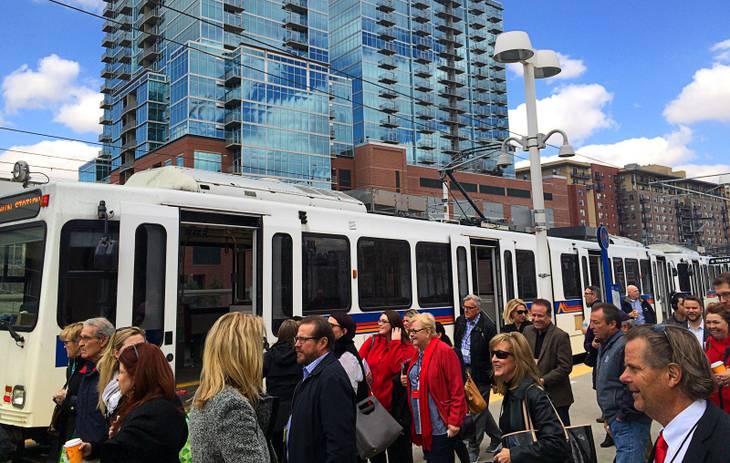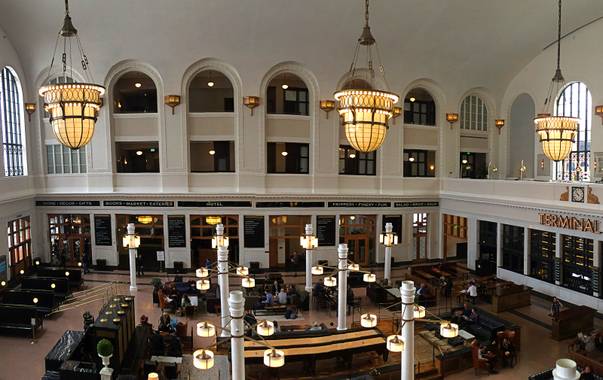DENVER — If Southern Nevada is going to emulate Colorado’s largest metro area by developing an ambitious light rail system, its elected officials and business community members will need to embrace one word: teamwork.
That was the message delivered to a group of about 50 Las Vegas leaders from the public and private sector on Tuesday. The group traveled to Denver to hear about the city’s major transit developments, hoping to learn about them firsthand as they consider whether and how Las Vegas should move forward with similar plans.
Led by the Regional Transportation Commission of Southern Nevada and the law firm Brownstein Hyatt Farber Schreck LLP, the group heard from several expert panels on such topics as public-private partnerships, funding for transit projects and private development that can stem from infrastructure work.
Members of the group included state legislators and local government officials, as well as representatives of the transportation commission, the Las Vegas Convention and Visitors Authority and elsewhere. Their trip was related to a proposal recently released by the commission for a Southern Nevada light rail system that could connect McCarran International Airport with the Strip and downtown Las Vegas — and potentially other areas, too.
Throughout the day on Tuesday, panelists stressed the importance of collaboration in making Denver’s transit development work smoothly.
For example, Tom Clark, CEO of the Metro Denver Economic Development Corporation, spoke on a history-focused panel about how Denver officials began to conceptualize the area as a connected region, not a loose collection of disparate cities. It didn’t start out easily, he said, but eventually Denver’s leaders generally embraced the idea of being a singular place, “not a bunch of cities fighting with one another.”
Denver’s light rail system started with more than five miles in 1994, and rail in the area has expanded dramatically since then. A 23-mile commuter rail line connecting downtown Denver with the airport will debut late next month, and three other rail lines will open later this year as well.
The aggressive expansion comes as part of FasTracks, a 2004 plan approved by voters that’s bringing 122 miles of new light rail and commuter rail to the Denver area, among other transit improvements.
Another big milestone for Denver transit was the 2014 renovations at Union Station, which the Las Vegas group visited in person Tuesday. The station opened in the late 19th century but has been transformed into a multimodal transit hub that includes a 112-room hotel, as well as restaurant, shopping and bar space.
After touring the station’s vast main terminal and hotel rooms, the Las Vegas group gathered for two more panels that shed light on the Union Station renovations and the role of federal funding in transit projects.
Once again, teamwork was the operative word.
During the first panel, Dave Genova, the interim general manager of Denver’s Regional Transportation District, said the region got “a lot of great support to do the things we wanted to do” at Union Station. He said local officials realized what the station could become and that they avoided clashing with one another.
Brownstein Policy Director Brian Wild made a similar point during the funding panel.
“One of the reasons Denver works, and works so well, is that everybody agrees on what the priorities are,” he said.
Wild, a Colorado native who has an extensive background in Republican politics in Washington, D.C., said that regional collaboration is key to getting federal money. He said that’s why Denver was able to get a more than $1 billion full-funding grant agreement for its rail expansion.
But regional collaboration produces more than just federal money for trains on tracks, panelists told the Las Vegas group. They said it can also bring substantial economic development that a metro area may otherwise never receive.
The tour’s selling point on that front was the site of a future facility for Panasonic Enterprise Solutions, which the group briefly toured in the afternoon. It’s being constructed near Denver International Airport — and right along the soon-to-open commuter rail line.
Jarrett Wendt, an executive with Panasonic Enterprise Solutions, said at a later panel that the commuter rail was a crucial component of why his company chose to build in Denver. He praised the “entrepreneurial leadership” of the Denver region, lauded the ability of its leaders to put politics aside to move development forward and called access to public transit an “essential” offering.
“You have to put in public transportation. You have to connect people in different ways than just their vehicle,” Wendt said. “You have to have that as part of your cityscape. Otherwise, it’s going to be business as usual.”
After the panels and tours had all wrapped up, Tina Quigley, general manager of the Regional Transportation Commission, posed a simple question for the group: What should the next steps be for Southern Nevada?
The answer is more complicated. Some suggested starting small — building light rail first on Maryland Parkway, perhaps, instead of immediately trying to get it done on the Strip. And Heidi Swank, a state assemblywoman from the Las Vegas area, noted the tough culture change that likely lies ahead if Southern Nevada wants to change the mindset of its car-reliant residents.
Still, the group seemed generally receptive to moving forward on Las Vegas light rail in some fashion.
Quigley said she heard a clear message in Denver that regional collaboration can make an area more competitive for federal grants, more attractive to companies who want to relocate and more prepared to get voters on board to invest in infrastructure. It can also mean “insane, grandiose economic development success” if pulled off well, she said.
But it requires aggressive leadership, and Quigley indicated that the transportation commission can only do so much.
“In Denver it was the private sector, those who were interested in economic development, who stepped up and helped give guidance to elected officials that this is where they wanted to head,” she said in an interview. “So I do call upon the private sector to be collaborating and communicating their messages to all of our elected officials in Southern Nevada. Then we will see stronger leadership evolve.”
More private sector support for light rail may emerge as the Southern Nevada Tourism Infrastructure Committee continues its work. That group is evaluating the region’s needs for new or improved stadiums, convention centers, roads, mass transit and other infrastructure that supports tourism. It’s already heard about the light rail proposal, and is scheduled to return to the issue before submitting a report to the governor this summer.

